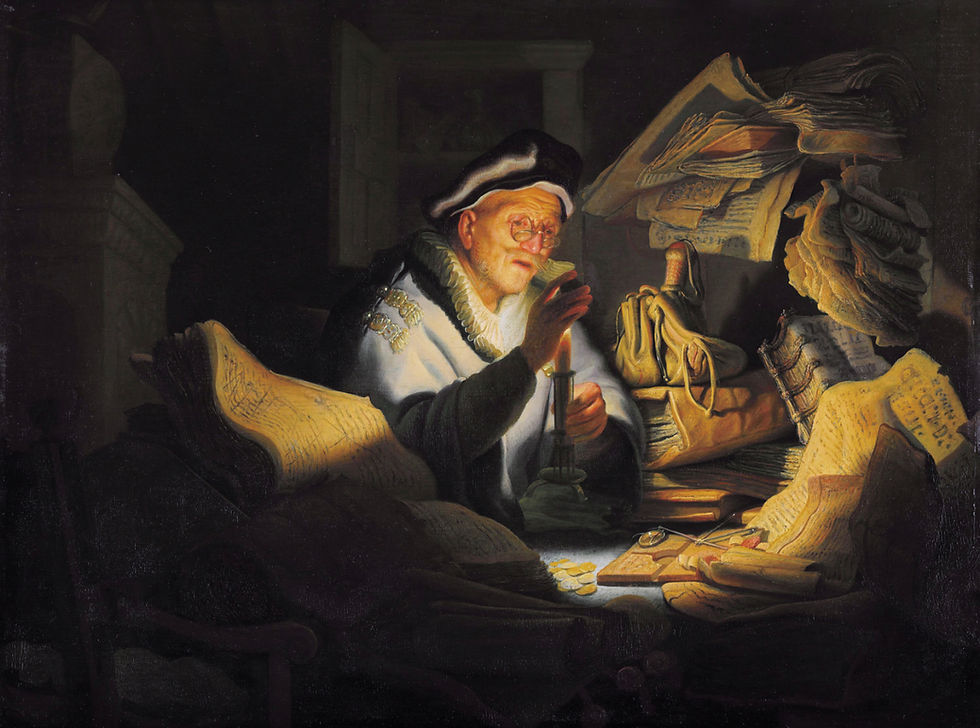Prudence in action
- Jean-Marie Chan Kin
- Nov 2, 2022
- 3 min read
In this painting, Rembrandt, considered one of the greatest visual artists in art history, portrayed an old man sitting at a table amid darkness, illuminated by a single candle. Gold coins and property titles are piled up around him. Wearing glasses, the old man has poor vision. The uncertain light from the candle and the clock on his table suggest that his days are numbered as the light is about to be extinguished.

False prudence
This man puts all of his comfort in the things that he owns. He believes his wealth will protect him for the rest of his life, and he doesn't think about his imminent death. He doesn't realize that the meaning of life is to will the good of others and to be of service to others. So, when he had the opportunity to do something for others, he could only think about himself.
Prudence leads us to choose the appropriate means to achieve a good end and to carry them out. That is not the case for this man. He is focused only on pleasure and sensible goods and seeks to enjoy and possess them without considering others. It's a selfish search for one's security without considering the needs of others.
True prudence
True prudence is the virtue that disposes of practical reason to discern our true good in every circumstance and to choose the proper means to achieve it. It answers the question of what will make us truly happy. As a Money Coach, I help my clients discern the answer to this question, what makes you and others around you happy? Another word for happy is blessed. Once we know the answer to this question, we can work on a plan to achieve that good end.
Deliberating: stopping to think
Three acts lead us to live the virtue of prudence: deliberating, deciding correctly and commanding. The first two occur when, as a Money Coach, I work with my clients to determine their financial situation. Here, we look at their net worth, including all their assets and liabilities:
· What is their asset allocation?
· How much is in real estate?
· Other assets?
· What is their asset mix?
· How much debt do they have?
We look at their current income and future earning potential. We benchmark their net worth to see how they are doing financially. How much better could they do if they make some small achievable changes? We examine whether they have adequate insurance to protect their livelihood and assets.
The careful study of the facts of their current financial situation is critical to help my clients understand how things truly are. Often, they realize that they are better or worse off than they thought, and this allows them to recalibrate their expectations in line with reality and helps them make the right financial decisions.
Deciding correctly
Indecision is another form of imprudence. Once you have deliberated, it's time to decide what to do. Here, I coach my clients to do what they ought to do to improve their financial situation, and I show them how to overcome their financial challenges. It is crucial that once you discern what you ought to do, you commit to it, even if the action does not look appealing, or if you don't feel like doing it, or if you worry about what others would say, or if you are afraid of making a mistake or for any other reason. It is useless to know what is the best thing to do if you don't decide to do it.
Commanding: taking action
Deliberating and deciding are not enough: we need to act. The prudent person now puts into practice what has been learned. By doing so, my client then reaps the benefit of this holistic approach to financial planning, knowing they will reach a good end that will bless them and those around them. Now they can grow old and see that they can continue to do good — both when they are still alive and when they leave this earthly pilgrimage.
Please book a free consultation if you want to find out how I can help you as a Money Coach.




Comments